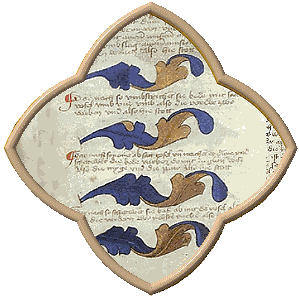|
Giles
de Laval
Everyone who has
beheld them realises that the manuscripts of the
Dark and Middle Ages are magnificent works of art,
imbued with mystical reverence and greatly
treasured by their owners. Yet few people realise
just how much they were treasured - even to the
point of going to war over.
In 561 AD, the abbot
Columcille (whose name was later Anglicised to
Columba), paid a visit to Finian, abbot of the
monastery at Moville. Unbeknownst to the abbot,
Columcille remained wakeful for many nights,
secretly copying a manuscript Finian had brought
from Whithorn monastery in Scotland. Some
historians claim that Columcille copied the Bible,
others believe it was the Gospel of St Martin.
Whichever it was, Finian discovered the deceit of
his guest and demanded that Columcille hand over
the copy he had made. He refused, and fled into the
night before Finian's monks could seize the
unauthorised copy.
Finian appealed to
Diarmuit Ui Neill, high king of Ireland and kinsman
to Columcille. After considering what may have been
the world's first copyright case, the high king
rendered his judgement: "to every cow belongs its
calf, and to every book its copy". He ordered
Columcille to turn the copy over to Finian, and
that should have been that.
However, even though
Columcille was a member of the Ui Neill clan and
kinsman to the high king, he identified with his
mother's family the clan o Donnell, according to
Celtic custom. The o Donnells did not recognise the
right of the upstart Ui Neills to hold the high
kingship of Ireland, so Columcille felt justified
in defying Diarmuit's order, declaring "the wrong
decision of the judge is a raven's call to
battle!"
This sparked the Cul
Dreimne, the Battle of the Books. (The copy
Columcille made became known as the cathac, or
battler.) On one side ranged the high king and his
formidable clan and allies, fighting to enforce his
royal edict; on the other was Columcille and his
clan and allies, fighting (ostensibly) for their
perceived right to disregard the law of the land
when it conflicted with their spiritual mission.
The opportunity to humble the Ui Neil forces and
possibly restore the o Donnells to their royal
status was also something of a bonus. Although
religious issues were at the heart of the dispute,
the battling sides were formed along family lines
and political connections, the two armies were
composed of mixed pagan and Christian troops, their
religious differences momentarily set aside by
political concerns. Monks and druids fought on both
sides, adding missiles of prayer and curse to the
swords and spears of their allies. When the
fighting was over, the blood of the Christians
soaked the ground as much as that of the
pagans.
Columcille won the day
at Cul Dreimne, but did not get to enjoy his
victory. According to the Beatha Colaim Chille
(Life of Columba), written by an o Donnell in 1532
AD, Columcille felt deep remorse when he saw the
slaughter caused by his pride. He vowed to leave
Ireland, to become a White Martyr and live out his
days in foreign lands. Far more likely, however, is
that he was forced into exile by the Synod of
Teltown, a meeting of loyal Ui Neill clergy
summoned by the high king. Columcille was almost
excommunicated for his theft by copy of Finian's
book: it was only the eloquent arguments of his
friend Brendan of Birr that convinced the Synod to
impose banishment as an alternative
punishment.
Whichever the reason,
Columcille gathered twelve disciples to him to form
the nucleus of a new monastery, and in 565 AD
embarked in coracles on the Irish Sea. In the
manner of a druid, he abandoned himself to the
elements, letting the winds and ocean currents
dictate his course. Finally the frail hide boats
reached the island of Iona off the coast of
northwest Scotland, and Columcille and his monks
established a monastery and scriptorium there. It
was there, more than two hundred years later, that
the most famous of all insular manuscripts, the
Book of Kells, is thought to have been written,
before the monastery had to be abandoned in 807 AD
in the face of increasing Viking raids on the
British isles.
Bibliography
Celtic
Sexuality, Peter Cherici, Duckworth
1994
Exploring the World of the Celts,
Simon James, Thames and Hudson 1993
The Northem World, David M Wilson ed,
Harry N Abrams 1980
|

